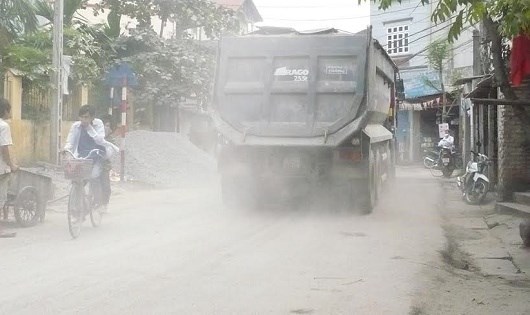
According to the Hanoi Construction Department, there are more than 1,000 construction sites, large and small, under execution in Hanoi. It is estimated that more than 10,000 square meters of road are excavated every month for projects to upgrade technical infrastructure.
A report of the Ministry of Natural Resources and the Environment (MONRE) also shows the serious decline in environmental quality in Hanoi partially because of construction activities.
The report says the city every year receives 80,000 tons of dust and smoke, 9,000 tons of SO2, 19,000 tons of NO2 and 46,000 tons of CO2.
The process of demolition, excavation, backfilling and carrying materials to the construction sites, using high-capacity diesel engine produces toxic gas such as SO2, NOx and CO, harm people’s health near large construction site areas.
|
The process of demolition, excavation, backfilling and carrying materials to the construction sites, using high-capacity diesel engine produces toxic gas such as SO2, NOx and CO, harm people’s health near large construction site areas. |
Le Van Luong, Khuat Duy Tien, Nguyen Xien and Bac Thang Long Roads have been cited as the ‘hot spots’ in Hanoi as the implementation of infrastructure projects there have been producing thick dust every day.
In Nam Tu Liem district, residents of An Sinh Residential Quarter complain they have been living in the dust produced by the construction site nearby.
Tran Ngoc Lam, 48, a taxi motorbike driver on Xuan Thuy Road of Cau Giay district, said he has to breathe dust and smoke every day as the Nhon-Hanoi Station elevated rail project still is under implementation.
“It is now the most beautiful time of the year. The situation will be worse in some months, when we have to suffer the summer heat and the terrible dust at the same time,” he said.
Meanwhile, domestic garbage, construction waste and sludge can be found in many places in the Thang Long Boulevard sections which run across Me Tri and Phu Do Wards in Nam Tu Liem district, and Anh Khanh, Lai Yen, Song Phuong and Van Con communes in Hoai Duc district.
This cones from vehicles carrying materials and construction waste to and from nearby construction sites that don’t follow the regulation on street sanitation.
Many vehicles are not closely covered, or washed before leaving the construction sites, thus bringing dust and sludge from the sites to streets and residential quarters.
In an effort to ease the problems, Hanoi in 2016 installed a series of air monitoring stations and put the Center for Regulation and Environmental Data Management into operation.
The city’s environmental protection agency will have the right to investigate, analyse the phenomena and suggest solutions to municipal authorities.
| related news |
Thien Nhien